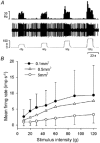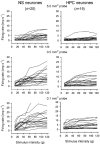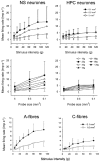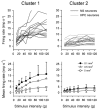Quantitative responses of spinothalamic lamina I neurones to graded mechanical stimulation in the cat
- PMID: 12482896
- PMCID: PMC2290712
- DOI: 10.1113/jphysiol.2002.027342
Quantitative responses of spinothalamic lamina I neurones to graded mechanical stimulation in the cat
Abstract
Nociceptive spinothalamic tract (STT) neurones in lamina I of the lumbosacral spinal cord of anaesthetized cats were characterized by recording their responses to graded mechanical stimulation with controlled forces of 10-120 g and probes of 5.0, 0.5 and 0.1 mm(2) contact area. Neurones were identified by antidromic activation from the contralateral thalamus, and cells that responded to noxious stimulation were categorized as either nociceptive specific (NS, n = 20) or as polymodal nociceptive (HPC, responsive to heat, pinch and cold, n = 19) based on their responses to quantitative thermal stimuli. The mean responses of the 39 units increased linearly as stimulus intensity increased, and the population stimulus-response curves evoked by each of the three probes were all significantly different from each other. Thresholds were 45 g for the 5.0 mm(2) probe, 30 g for the 0.5 mm(2) probe and 20 g for the 0.1 mm(2) probe. Further analysis showed that the NS neurones encoded both stimulus intensity and area (probe size) significantly better than HPC neurones in terms of their thresholds to individual probes, their peak discharge rates, their suprathreshold responsiveness and their ability to discriminate the three different probe sizes. These differences are consistent with the known differences between the mechanical encoding properties of A-fibre nociceptors, which provide the dominant inputs to NS neurones, and C-fibre nociceptors, which are the dominant inputs to HPC cells. Comparison of the stimulus-response curves of NS and HPC neurones indicated that the discharge of NS neurones better match the psychophysics of mechanical pain sensations in humans than the discharge of the HPC neurones do. Our findings support the view that NS neurones have a prominent role in mechanical pain and sharpness, and they corroborate the concept that the lamina I STT projection comprises several discrete channels that are integrated in the forebrain to generate qualitatively distinct sensations.
Figures












References
-
- Adriansen H, Gybels J, Handwerker HO, Van Hees J. Nociceptor discharges and sensations due to prolonged noxious mechanical stimulation – a paradox. Human Neurobiology. 1984;3:53–58. - PubMed
-
- Andrew D, Craig AD. Spinothalamic lamina I neurons selectively sensitive to histamine: a central neural pathway for itch. Nature Neuroscience. 2001a;4:72–77. - PubMed
-
- Andrew D, Craig AD. Responses of spinothalamic lamina I neurons to maintained noxious mechanical stimulation in the cat. Journal of Neurophysiology. 2002;87:1889–1901. - PubMed
-
- Andrew D, Greenspan JD. Peripheral coding of tonic mechanical cutaneous pain: Comparison of rat nociceptor discharge and human psychophysics. Journal of Neurophysiology. 1999;82:2641–2648. - PubMed
Publication types
MeSH terms
Grants and funding
LinkOut - more resources
Full Text Sources
Miscellaneous

